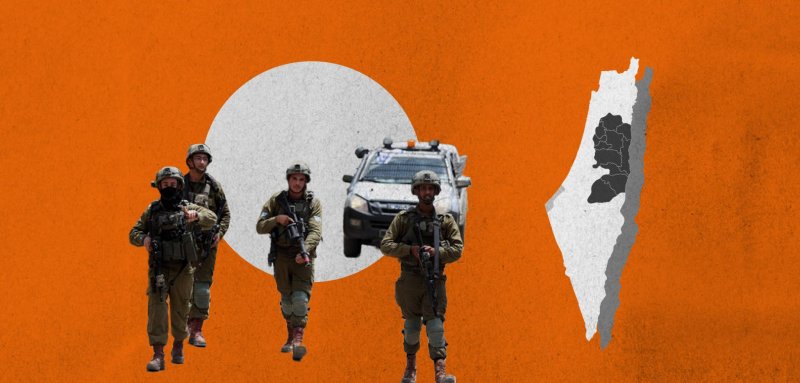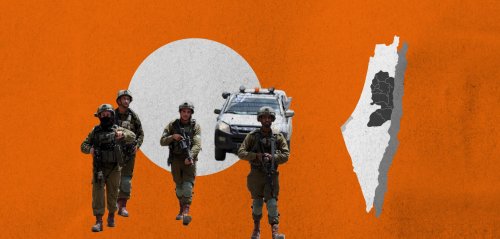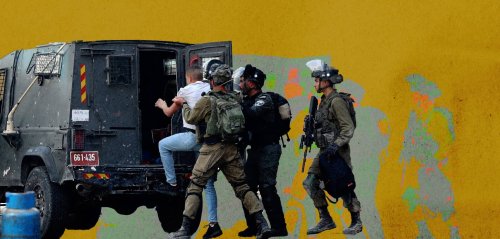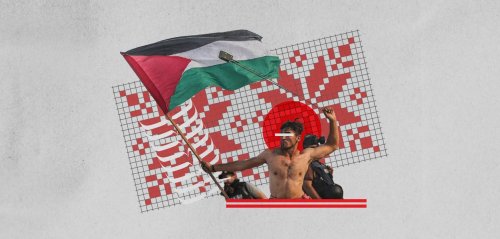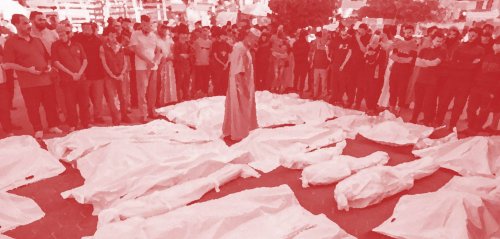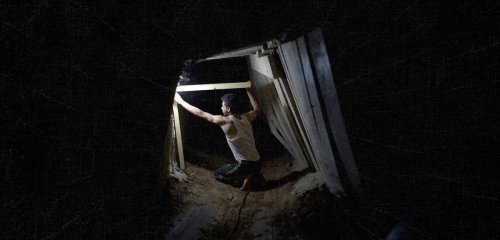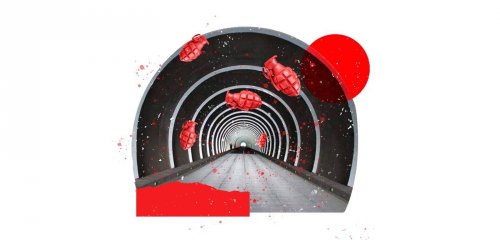As Israel’s war on Gaza enters its second month, ground, sea, and air bombardments continue to escalate at an alarming pace. The result is a dangerous increase in the number of massacres and atrocities committed against Palestinians in the besieged Strip. Since the outset of this aggression, the West Bank finds itself in a challenging position on multiple fronts. The magnitude of Israel’s attacks far surpasses its ability to resist.
In this report, we explore the political and military role of the West Bank, and their impact on the armed resistance as Israeli forces deepen their incursion and the ground war enters its second week.
It is important to note that the West Bank, approximately 5,660 square kilometers, accounts for approximately 21% of the land of 'Historic Palestine'. The Gaza Strip, at 365 square kilometers, constitutes roughly 1.33% of 'Historic Palestine'. Gaza, with a population of over 2.375 million by the end of 2022, is one of the most densely populated areas in the world.
Between the West Bank and the Gaza Strip
We spoke with Professor Hassan Ladadweh, a sociology lecturer in the Department of Social and Behavioral Sciences at Birzeit University. Ladadweh highlights a key difference between the West Bank and Gaza, explaining, “One of the most significant differences affecting the West Bank and Gaza is the political landscape post the Oslo Accords and its impact on social dynamics. We are talking about two regions operating under different authorities; one in Gaza that views itself as an extension of the resistance, prioritizing militant actions, while the other in the West Bank sees itself as part of the Oslo commitments, prioritizing the fulfillment of these agreements. This has given rise to specific factions leaning towards compromise or maintaining the status quo.” Professor Ladadweh emphasizes that the armed resistance has an active role in the West Bank.
Armed resistance in the West Bank operates at varying levels, according to Professor Ladadweh, influenced by the local environment and political surroundings.
He explains to Raseef22, “In Gaza, despite the deadly impact of the blockade (ongoing since 2007), and the occupation's goal to create a fragmented state, aimed at weakening society and its armed resistance, the opposite has occurred, as evidenced by the events of October 7th.” Ladadweh continues, "The same holds true for the West Bank, where the occupation sought to create a policy based on the carrot-and-stick method (coercion and reward), fostering divisions among the population based on loyalty. This aimed to create a confrontation between groups, as one side defends peace, stability, and compliance, while the other defends the resistance. However, the results did not go as planned, as seen by the surge of resistance, especially over the last two years, and particularly in the northern West Bank.”
As Israel’s war on Gaza enters its second month, and its ground invasion enters its second week, what role does the West Bank play?
Ladadweh underscores that "the West Bank's geographical setting offers more favorable conditions for armed resistance compared to that of Gaza, to varying degrees. Factors such as size, topography, population distribution, the presence of settlements in proximity to population centers, and direct daily interaction with Zionists contribute positively to the potential for resistance."
Various forms of resistance
Since the onset of operation Al-Aqsa Storm, the West Bank has expressed solidarity with Gaza, protesting and engaging in various confrontations with Israeli security forces. Under the protection of Israeli military and security forces, settlers have been able to engage in various acts of violence against residents. According to a statement made by the Palestinian Ministry of Health on Tuesday, there have been 163 casualties across both the West Bank and Jerusalem since the start of the war.
Dr. Mahmoud Al-Fatafta, a professor of media and politics at the American Arab University and founder of Researchers Without Borders shares, "the Israeli occupation's war in the West Bank has been ongoing since its occupation, and resistance takes on varied forms, shaped by factors such as security coordination, internal divisions, a somewhat negative view towards resistance, and the Israeli pursuit of resistance fighters. Despite Israel's measures, revolutionary fervor and resistance activities in the West Bank are expanding geographically and diversifying in tools and actions. There is no doubt that armed action will take various forms and expand further, especially with the expansion of the ground operation in the Gaza Strip.”
Al-Fatafta also discusses potential methods to activate resistance in the West Bank, including "increasing the size and number of marches, sending supplies and medical equipment to Gaza, exposing Israeli crimes internationally through lectures and articles to human rights and international institutions, in addition to expanding and activating armed confrontations with the occupation. All of this must be accompanied by the formation of popular protection committees in every residential area to protect against settler attacks, with the authority not restricting those who raise their voices or carry weapons against the occupier."
According to former major general and military analyst Wassef Erekat, “as Israel intensifies its attacks, the resistance adopts more comprehensive and violent forms, and the manifestations of armed resistance diversify. The youth of the West Bank have previously carried out painful individual operations.” Erekat highlights that "the formation of resistance brigades from the younger generation prompted Israel to try to hinder their growth in the West Bank through three military plans (ongoing since early 2022), under the names 'Break the Wave', 'Pressure Cooker Protocol', and the 'Mowing the Grass' strategy."
Erekat states, “Israel has executed and continues to carry out incursion operations into most Palestinian camps, villages, and cities in the West Bank, to achieve its declared objective. However, resistance factions have successfully countered these efforts, inflicting losses on the enemy and preventing them from achieving their goals, despite the magnitude of destruction and human losses resulting from these incursions and aggressive operations.”
Erekat adds that “the West Bank and its resistance are depleting the equivalent of a quarter of the Israeli army, its police, and security apparatus. In addition to the material and moral losses inflicted by the resistance, the West Bank front remains ignited, in a constant state of conflict and clashes, which has been a shock to them and has disrupted their calculations.”
Comprehensive explosion
As the war on Gaza continues, the Israeli army has moved to disable communications in the West Bank, reinstating checkpoints and enacting collective punishment. These actions, according to Erekat, “have been met with more clashes by resistance forces against settlers and the army alike. The situation is steadily escalating, poised for a comprehensive explosion.”
Hani al-Masri, the director of Masarat, the Palestinian Center for Policy Research and Strategic Studies, discusses "the role of the West Bank in supporting the resistance, albeit at a lower pace, due to certain conditions." “The primary and chief reason is the occupation,” al-Masri explains, “Israel imposed a strict blockade, severed the connections of the West Bank, and completely closed it off, erecting barriers. Movement from one governorate to another became a virtual impossibility, turning the governorates into large prisons. The occupation carried out assassinations and mass arrests, with around 2,100 detainees since the beginning of the aggression.”
The second reason is attributed to the presence of an authority that avoids participation. Rather, it generally aims to control the situation, seeking to prevent friction and violence between protesters and occupation forces.
The third factor is when firearms come into play, diminishing the importance of other forms of resistance, especially since the West Bank is generally not armed.
Finally, in locations where weapons are present, such as in the northern governorates, armed clashes exist although they are not widespread. Over the last two years, resistance groups have been impacted by assassinations and arrests by Israeli forces, as well as efforts by Palestinian authorities to contain them. These were the rough circumstances in the West Bank when Operation Al-Aqsa Storm occurred.
As the war on Gaza continues, the Israeli army has moved to disable communications in the West Bank, reinstating checkpoints and enacting collective punishment. This has been met with more resistance and escalating violence against settlers and the army
Al-Masri adds that the war could lead to greater resistance – within groups, and also through the involvement of individual Palestinian security personnel. “The continuation of the war in this barbaric manner, its escalating intensity, and the evolving dynamics with the ground invasion, along with the resilience and potential gains by the resistance, have the power to instill hope.”
According to Al-Masri, “A man working in the security apparatus was martyred while fighting with the resistance in the northern West Bank.” This indicates a potential rise in individual involvement in Palestinian resistance.
Abbas Zaki, a member of the Fatah Central Committee (FCC), explains to Raseef22 that “despite threats and summons by the occupation, people in the West Bank are still taking to the streets to demonstrate and head to critical areas of contact to express their inner sentiments amidst a volatile atmosphere [...] people's hearts are on fire.”
He adds, “Many people wish they had weapons, but everyone knows the restrictions imposed on us due to our involvement in the peace process, which limits the West Bank from playing its role to the fullest. I believe this needs a reassessment and the adoption of strategic measures so that it will be in the right place and position.”
Zaki concludes that “the blood in Gaza and the exceptional situation there may bring significant surprises, and I am confident that change is coming to all of Palestine.”
Raseef22 is a not for profit entity. Our focus is on quality journalism. Every contribution to the NasRaseef membership goes directly towards journalism production. We stand independent, not accepting corporate sponsorships, sponsored content or political funding.
Support our mission to keep Raseef22 available to all readers by clicking here!
Interested in writing with us? Check our pitch process here!
